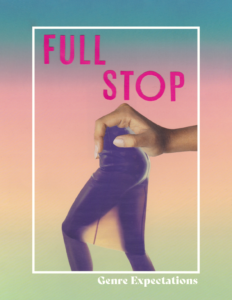The following is the introduction to the latest issue of the Full Stop Quarterly. You can purchase the issue here or subscribe at our Patreon page.

For a while now, the cracks were beginning to show. The rumbling possibility that some things might be going wrong—that the structure of our plans, of our lives, might just fall apart, along with those of millions of others. But we can acknowledge looming catastrophe without making a single change in our daily lives. The change only happens when we no longer have a choice. Now it’s happening. And the happening has brought with it a dizzying sense of before and—not after, but during. In the during, there’s a strange quaintness to the temporality of before, in which you might blithely make plans and fully expect them to hold.
On an (unplanned) transatlantic flight, one exhausted editor decides to watch Inception. The choice doesn’t stick—too much roving anxiety to watch a whole movie, even when confined to an airplane—but enough plays to introduce the primary visual trope of the film: The end of the dream is signaled by reality beginning to crumble, as though caused by a thorough, deliberate earthquake. Falling walls and burst water mains give way to another reality, fully intact. It’s not the slow shift we’re used to, like when you look at an old picture and are struck by what’s changed, gradually, over years. Such change, even when dramatic, is already explained by sequences of events in the timeline that you’re still in. At some point, this during we’re now in will be reincorporated into such a timeline. But so far, this hasn’t happened. So the image from Inception has stuck—the slow, steady demolition; the rupture, no link between before and after.
As we all try as well as we can to keep the virus out of our homes, our organisms, it has nevertheless infiltrated every corner of our minds. And so here it is, in this editorial, where it has no business. Or does it?
We are introducing an issue of the Full Stop Quarterly about genre, its limits, and the liberatory potential we discover at the edges of generic forms—a potential determined by the structures of those forms, yet also capable of transforming them. Our new awareness of just how delicately held together our daily lives have always been appears to open up the necessity for new generic relations with reality. As we stare into the terrifying blankness of the future, the essays gathered here can help us reconsider the ways that meaning is made.
What might appear fixed to the untrained eye—because it is literally set in stone, or because it might as well be—is in fact only seemingly so. As Jaime Groetsema shows us, in the case of the Dionysus Sardanapalus, the intentional or accidental misidentification of a statue resolves over time into a stable contradiction. Origin, history, facts, are exposed as not determinative of meaning, but rather as participants in its ongoing production, which never ends. In Yuxin Zhao’s consideration of Chinese reality TV idols and the elaborate culture of slash fiction that surrounds them, we see that the same is true of heteronormativity and of binary conceptions of gender. In these and other essays, practices that might appear to reinforce stable categories instead are shown to transform them. Such practices—of establishing history, narrating the self, articulating desire—are both shaped by and in tension with familiar and legible generic forms, which appear at once productive and entropic.
Of course, genres themselves are completely contingent: caught in time and negotiated between human beings. Genres have and depend on histories, on communities of authors and audiences—and on futures. Reflections here on trans memoir-writing, on narrating sci-fi from the perspective of an “us,” on the fictionality of theory, not only present us with specific histories of literature and culture, but also consider and critique the ways that history is written.
It’s hard not to live generically. By which we mean: However threatening and unknowable the abstract future has long seemed, we tend to assume that tomorrow, next week, next year will have a predictable shape. The planes will fly. The schools will be open. With even such basic infrastructural certainties suspended, we must think about the structures that held them in place—not just materially, but also in our collective imaginaries. Perhaps these essays will give us some tools for living together in the during, and for relating to whatever future is to come.
This post may contain affiliate links.







